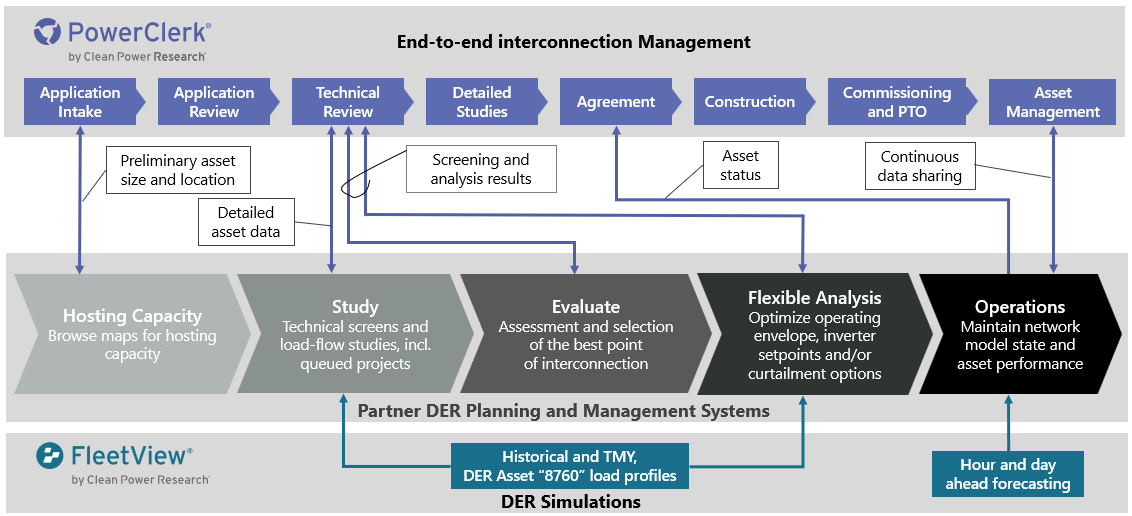As electrification and adoption of distributed energy resources (DERs) accelerate, utilities are facing a pivotal challenge: managing growing complexity while balancing grid flexibility, service reliability and customer satisfaction. Utilities today are navigating a plethora of DER types—solar panels, batteries, EV chargers, smart thermostats and more—and a patchwork of legacy systems.
Onboarding these assets into Distributed Energy Resource Management Systems (DERMS), or Virtual Power Plant (VPP) programs, is often a slow and fragmented process, plagued by manual workarounds, redundant data entry and siloed communications. This can result in bottlenecks, inefficiencies and missed opportunities.
Utilities can avoid these challenges by intelligently integrating best-of-breed software systems.
Why integration matters
Integrating PowerClerk® and FleetView® with power planning and grid management platforms like DERMS, Demand Response Management Systems (DRMS) and VPPs is proving to be a game changer.
As the leading interconnection management platform, PowerClerk offers robust workflow automation, seamless communication with DER stakeholders and deep integration capabilities, while FleetView can offer simulated DER Asset 8760 load profiles. When combined with DER management systems, PowerClerk and FleetView transforms DER asset enrollment, registration and management from a pain point into a strategic advantage.
Plug-and-play power: PowerClerk Service Connectors
PowerClerk’s integration strategy centers on Service Connectors—modules that enable plug-and-play compatibility with partner platforms. These connectors eliminate the need for lengthy custom IT projects. PowerClerk ensures utilities can integrate quickly and effectively whether it’s linking to geospatial data in Esri, automating grid studies with envelio, or syncing with DERMS platforms from partners like Mitsubishi Electric Power Products, Inc. (MEPPI) and soon GE Vernova and others. Even without a PowerClerk pre-built Service Connector, integrating via PowerClerk’s API is straightforward as shown in this blog and video by James Latham, Sr Technical Product Manager for Integrations.

This diagram illustrates where integrating PowerClerk and FleetView with grid partner platforms provides the most benefit
Benefits of PowerClerk integrations
By combining PowerClerk’s workflow automation with grid management systems, utilities realize significant benefits on multiple fronts, including:
- Automated DER asset registration – Approved DER data flows directly into DERMS or VPP systems, eliminating duplicate entry and reducing human error.
- Data continuity – As customer or asset details change, PowerClerk keeps all systems in sync, ensuring operators always have accurate, validated data.
- Operational efficiency – Automated workflows reduce administrative overhead, accelerate interconnection studies and help meet regulatory timelines.
- Customer engagement – Built-in communication tools keep DER owners and installers informed, while also enabling seamless enrollment into programs like demand response or VPPs.
- Scalability – This integrated approach supports a wide range of DER types and ownership models, from rooftop solar and storage, to EV fleets, making it future-proof.
- Grid flexibility – With DERs orchestrated as grid assets, utilities can respond to peak demand or local constraints without costly infrastructure upgrades.
- Increased revenue opportunities – Accommodating more load means higher energy sales. Utilities can also tap into new revenue streams such as State incentives offered for implementing Non-Wire Alternatives (NWA) projects and VPP market participation.
A win-win for utilities and customers
Imagine a customer installing a solar-plus-storage system. With PowerClerk integrated into the utility’s DERMS, it’s possible to automatically enroll that customer into a VPP program during the interconnection process. In this scenario, the utility gains a flexible asset that can be used for grid stability, while at the same time increase income through revenue stacking for customers. It’s a win-win that scales.
The bigger picture: resilience and growth
Ultimately, these integrations are about more than just efficiency—they’re about resilience and growth. As climate events become more extreme and energy demand increases, utilities need agile tools to adapt. PowerClerk and FleetView’s integrations with grid modeling and management platforms equips them to “say yes to more load” without compromising reliability or resiliency.
By leveraging distributed resources instead of defaulting to traditional poles-and-wires upgrades, utilities can build a more resilient, flexible and customer-centric grid. And they can do it faster, more affordably and with greater transparency.
Final thoughts
“Better together” isn’t just a slogan—it’s a strategy. PowerClerk’s role as the interconnection management platform and FleetView as a virtual “DER meter” complement the real-time control and analytics of grid-side systems. Together, they create a streamlined DER onboarding pipeline that breaks down silos and unlocks new value.
For utility leaders, regulators and technology partners, this is a call to action: embrace integration, accelerate innovation and build the grid of the future—today. Contact our team to discuss and learn more.
